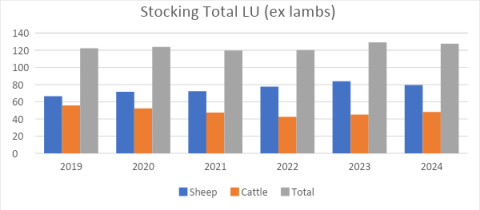Glascoed Project Update July 2024
Summary of the performance review at Glascoed 2019 to 2024
Land
John Nutting, Alwyn’s great grandfather moved to Glascoed in 1929 from Llangyniew. Since then, it has been farmed by his grandad, Trevor and father John Nutting. It is likely that Alwyn’s son Dylan will take over in the future. The land extends to 200 acres of owned grassland, 50 acres rented and rights for 150 ewes on a common. All the land is grassland but stubble turnips are planted before a reseed. There is a good range of farm buildings for cattle and sheep housing.
Figure 1. Map of land at Glascoed Farm
Welsh Mule and pure Welsh ewes have been kept in the past but the crossbred flock has now transitioned through Aberfield to Highlander. 560 cross bred ewes and 130 Welsh ewes are currently on the farm as well as 150 ewe hoggs.
The suckler herd has reduced from 40 cows to 15 at present. The herd is currently moving towards the Stabiliser breed but the future of the herd is uncertain.
Figure 2. Stocking total Livestock Units at Glascoed Farm
Changes over the past five years
Stocking has been maintained at between 120 and 130 LU on the 250 acres or 1.18 to 1.28LU/ha. This has been achieved despite a 36% reduction in use of N and a 76% reduction in concentrate feed use for the sheep.
Nutrient management
Alwyn had a nutrient management plan completed through Farming Connect in 2020/21 and continues to take annual soil samples to assess the need for fertiliser and lime. Six fields sampled in April ‘24 showed an average pH of 6.2 with one field needing lime, with most fields at index 2+ for phosphate, 2- for potash and 3 for magnesium.
Fertiliser use
Various sources of fertiliser have been used in the past including compounds, urea, poultry manure and lime. The poultry manure has been assumed to be 50% dry matter and to contain 5kgN/t, 8.7kgP2O/t, 16.5kgK2O/t, 6.9kgSO2/t and 5.1kgMgO/t based on RB209 standard values. N applications have fallen by 36%, P by 83% and K by 72%. This is largely due to the use of red and white clover and herbal leys.
Nutrient applications
Red clover
Four years ago, 9 acres of a red clover/PRG were sown (usually the land is ploughed, power harrowed, stubble turnips planted, sward lifted and seed scratched in for a new ley). In the first two years the field cropped well with 12 to 14t of DM/hectare taken in three cuts. The aftermath carried a lot of lambs but lambs did not grow particularly well as iodine deficiency was identified.
Herbal leys
In the first year the new herbal leys worked well and lambs finished quickly but by the second year nearly all the chicory had gone. White clover has done well in the mix but Alwyn has needed to weed wipe to get rid of thistles.
Ewe feeding
Most ewes are housed for lambing but over the past 5 years concentrate use has been steadily reduced as better silage has been produced. Concentrate use has fallen from about 20 tonnes in 2019 to around 6 tonnes in 2024. Over those years Alwyn has moved away from making clamp silage, with the associated pollution risk, to making big bale silage of much better quality (10 MJ/kg DM for clamp and 11.5 MJ/kgDM for big bales).
Figure 3. Concentrate use at Glascoed
Worm control
Faecal Egg Counts (FEC) are done every 2 to 3 weeks depending on the time of year and dirty lambs are targeted for treatment. Tests are done on the farm using the modified McMaster procedure. Resistance testing has been carried out through Farming Connect which found resistance to white drench (benzimidazoles).
Herbal leys/reseeds have helped to reduce use of wormers.
Carbon footprinting
All fields have been soil sampled and analysed for soil carbon as a baseline in order to measure the effect of changes in management.
Trace element deficiencies
In 2021 a mineral audit was carried out through Farming Connect revealing some key issues:
- High calcium intake which could influence uptake of manganese, zinc copper, cobalt iodine and selenium by stock.
- High sulphur intake which can impact on copper and selenium uptake
- High iron which will affect copper availability
- Low iodine intake at peak requirements for ewes and lambs
- Low selenium at peak demand for ewes and lambs
Advice was to reduce sulphur applications (largely from poultry manure), monitor copper status by blood and liver sampling and to provide selenium and iodine supplements to ewes and lambs.
Sheep are bolused with Agrimin 24/7 (4.2mg iodine, 0.8mg cobalt, 0.4mg selenium each day for 180 days) twice a year (£2.40/ewe) and lambs are also treated pre-weaning.
Farming Connect discussion group
Alwyn was an active member of the North Montgomeryshire Sheep discussion group from 2020 to 2022. This involved regular meetings and input of data to Measure to Manage.
Action plan for the future
- It has been suggested that a trial be set up to test three trace element supplements on lambs this season.
- Alwyn plans to critically assess the profitability of the suckler herd.



